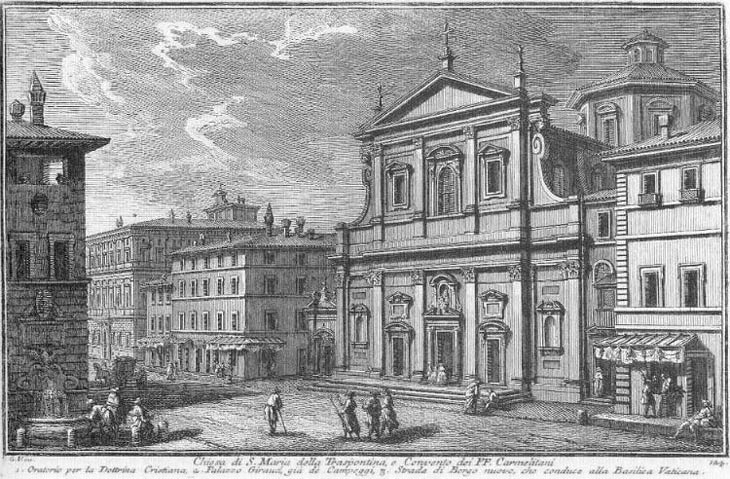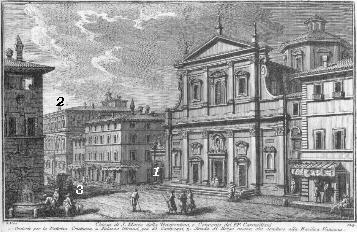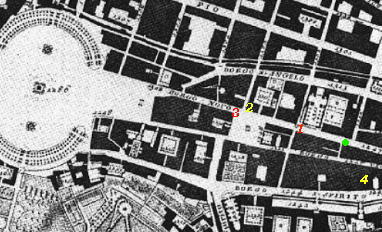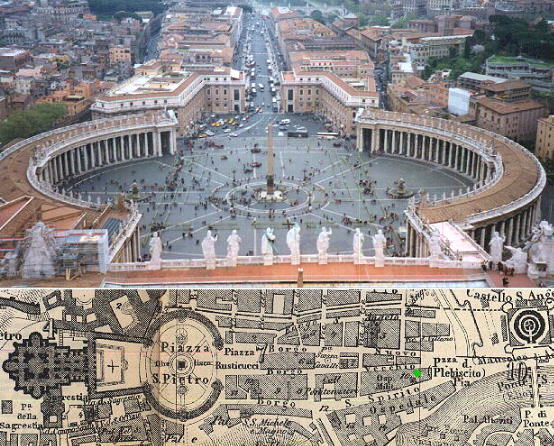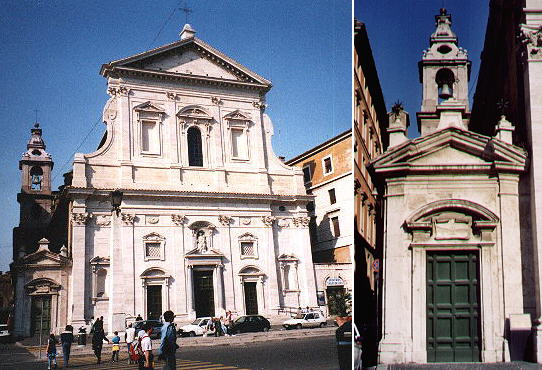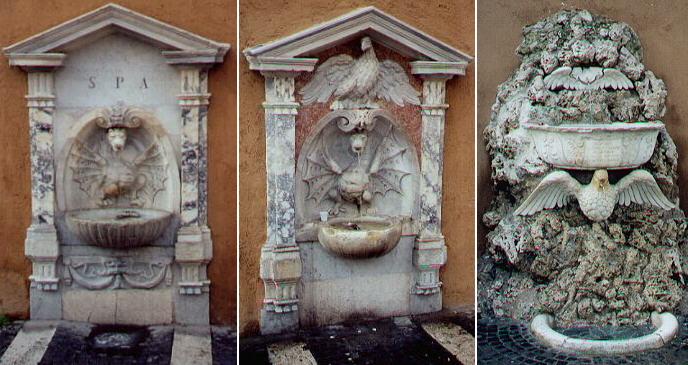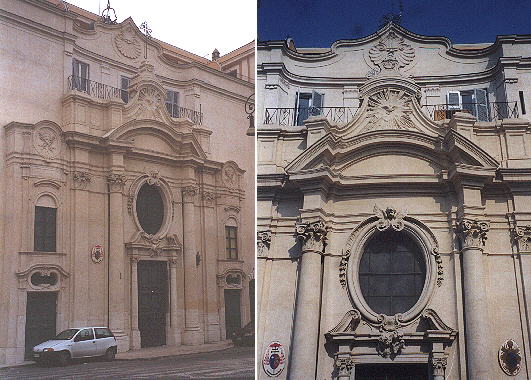

Chiesa di S. Maria
della Traspontina (Book
7) (View C3) (Map
C2) (Day 8) (Rione Borgo)
In this page:
The plate by Giuseppe Vasi
Today's view
S. Maria in Traspontina and Oratorio per la Dottrina Cristiana
Oratorio di S. Maria Annunziata
The Plate (No. 124)
Traspontina means simply beyond the bridge (ponte) in this case the
bridge of the Angels. The pilgrims were now very
close to their final destination: St Peter's. Vasi shows people
going only in that direction. Many shops (as today) relied on the foreigners
for their business. The view is taken from the green dot in the small 1748 map here below.
In the description below the plate Vasi made reference to: 1) Entrance to the Oratory;
2) Palazzo Giraud; 3) Street leading to
Basilica Vaticana.
The small map shows also 4) Oratorio di S. Maria Annunziata.
Today
Today the approach to St Peter's from the bridge of the Angels is
quite different. A "grand" entrance to St Peter's was completed in the 1950s
at the expense of Spina (thorn) di Borgo (the buildings between Borgo Nuovo
and Borgo Vecchio) and Piazza Rusticucci. Many palaces were pulled
down (Palazzo Accoramboni, Palazzo dei Convertendi, Palazzetto di Giacomo
Bresciano) others were erected in a sort of Renaissance style. Try to approach Piazza S. Pietro through Borgo
S. Spirito. The view is taken from St Peter's dome.
S. Maria in
Traspontina
S. Maria in Traspontina is with Palazzo
Giraud (now Torlonia) one of the few buildings which have not been
affected by the restructuring of the area. It was rebuilt in the late XVIth
century on a previous very old church and it was the main church of Borgo. Next to it there is a small oratory (Oratorio per la Dottrina Cristian)
where children received their religious education. It was designed in 1714 by Nicola Michetti.
The plate shows also one of several small fountains built by Paulus V. Two of them have been
reconstructed in one of the palaces along Via della Conciliazione. A third one (right) is now near S. Alessio. They show the
eagles and dragons of the Borghese family.
Oratorio di
S. Maria Annunziata
The little oratory of S. Maria Annunziata was built in 1746 by Pietro Passalacqua. It
shows the influence of Borromini in the use of convex and concave lines. The building
was located in Borgo S. Spirito (n. 16 in the map - marked with a green dot) opposite the
hospital. Because of the restructuring of the area the oratory was pulled down and
rebuilt in a new site opposite the large bridge (ponte Vittorio) which now
links the Vatican with the center of Rome.
Excerpts from Giuseppe Vasi 1761 Itinerary related to this page:
Chiesa di s. Maria della Traspontina
Conserva questa chiesa il nome dell'antica, la quale per la sua picciolezza, e per essere poco dopo il passaggio del suddetto ponte,
si disse Traspontina, e fu demolita per dare luogo alle fortificazioni e fossi intorno al divisato castello. Perciò Pio IV. nell'an. 1566. ordinò,
che si facesse una nuova chiesa, ma con magnificenza; e però essendo coll'ajuto di molte persone pie, specialmente del Card. Alessandrino,
terminata l'anno 1587. con disegno del Paparelli, e di Ottaviano Mascherini, Sisto V. le conferì il titolo Cardinalizio. Quei Religiosi con solenne
processione dalla chiesa vecchia andarono alla nuova portando il santissimo Sagramento, una immagine della ss. Vergine, che avevano portata
da Terrasanta, quando vennero in Roma, le colonne alle quali furono legati, e flagellati i ss. Apostoli Pietro e Paolo, ed un Crocifisso, con alcuni
corpi santi, e reliquie. Fu dipoi la chiesa ornata con cappelle incrostate di marmi, e pitture non poche; la s. Barbera nella prima a destra è del
Cav. d'Arpino, il s. Canuto nell'altra è di Monsù Daniele, la ss. Concezione nella terza è del Muziani, e le pitture nella quarta sono di
Bernardino Gagliardi; il s. Alberto nella quinta è di Antonio Pomaranci, ed il quadro con s. Maria Maddalena de' Pazzi nella crociata è di
Domenico Perugino, il quale dipinse a fresco gli angoli nella cupola. L'altare maggiore ove si custodisce l'immagine della ss. Vergine, è ornato
di marmi, sculture, e metalli dorati secondo il disegno del Cav. Carlo Fontana, e li due quadri grandi nel coro sono stati fatti ultimamente da
Angelo Papi.
Il s. Andrea Corsini nell'altra cappella della crociata è di Gio: Paolo Melchiorri, e le pitture nella volta sono di Biagio Pucci.
Il s. Ang. Carmelitano nell'altra, ed il resto delle pittture sono di Gio: Batista Ricci, e la s. Teresa nella cappella, che segue è di Giacinto
Calandrucci Palermitano. Il quadro nella cappella, ove sono le colonne, a cui furono legati e flagellati i ss. Apostoli Pietro e Paolo, è del
suddetto Ricci da Novara, il s. Elia nella penultima, di Antonio Gheraldi, e nell'ultima vi sono i corpi de ss. Basilide, Tripodio, e
Magdalo martiri, e nella sagrestia fra l'altre reliquie si annovera il capo di s. Basilio Magno. Nell'oratorio contiguo evvi il quadro
dell'altare dipinto da Luigi Garzi.
|
Next plate in Book 7: S. Martino ai Monti
Next step in Day 8 itinerary: S.
Giacomo a Scossacavalli

Go
to  or to Book
7 or to my Home
Page on Baroque Rome or to my Home Page on Rome
in the footsteps of an XVIIIth century traveller.
or to Book
7 or to my Home
Page on Baroque Rome or to my Home Page on Rome
in the footsteps of an XVIIIth century traveller.
|


